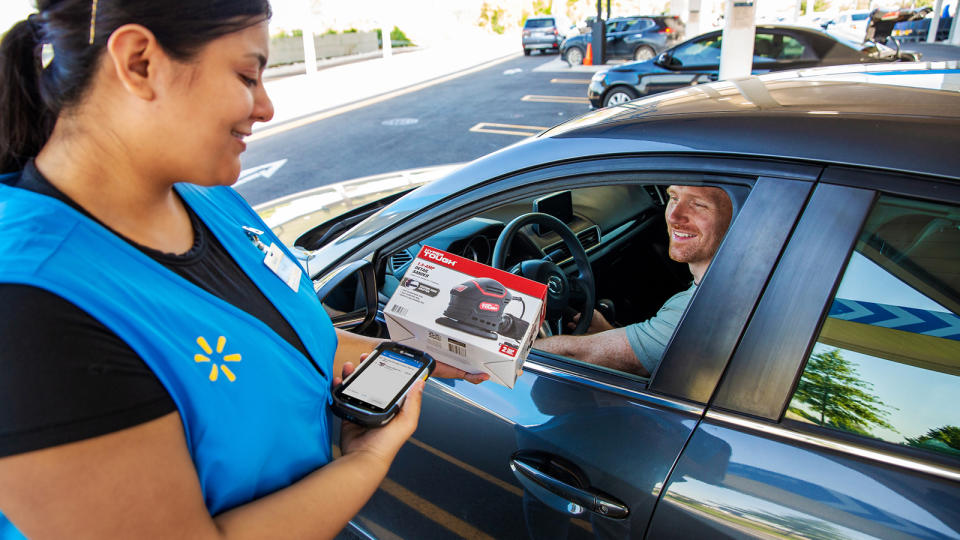Walmart Raises Outlook Thanks to Strength in Grocery, Expects $4.1 Billion Headwind for the Year

Walmart is attracting shoppers in an era of inflation thanks to its discounted prices.
The mass-channel merchant revealed quarterly earnings Tuesday before the market opened, improving on top-line sales thanks to continued strength in grocery, but logging a $1.8 billion loss for the quarter, partially because of inflationary pressures. Still, the retailer raised its full-year outlook, expecting continued sales growth, after what it considers a strong third quarter.
More from WWD
Shares of Walmart closed up 6.57 percent to $147.48 Tuesday as a result.

“We had a good quarter with strong top-line growth globally, led by Walmart and Sam’s Club U.S., along with Flipkart and Walmex,” Doug McMillon, president and chief executive officer of Walmart said in a statement. “Walmart U.S. continued to gain market share in grocery, helped by unit growth in our food business. We significantly improved our inventory position in [the third quarter] and we’ll continue to make progress as we end the year. From the ‘Big Billion Days’ in India through our ‘Deals for Days’ events in the U.S. and a Thanksgiving meal that will cost the same as last year, we’re here to help make this an affordable and special time for families around the world. We have an amazing group of associates [who] make all this happen and I want to say thank you.”
For the three month period ending Oct. 31, top-line revenues grew 8.7 percent to nearly $153 billion, up from $140 billion during last year’s third quarter. Net sales in Walmart U.S. were nearly $105 billion, up from $96.6 billion a year ago. Net sales in Walmart international also rose to $25.3 billion, up from $23.6 billion, negatively impacted by $1.5 billion currency fluctuations. Net sales at Sam’s Club were $21.4 billion, up from $19 billion last year.
Walmart U.S. comp sales increased 8.2 percent during the quarter, while Sam’s Club’s comp sales grew 10 percent.
The firm said more higher-income shoppers are coming to Walmart in search of discounts as inflation persists.
“Regardless of income, families are more price conscious now,” McMillon told analysts on Tuesday morning’s conference call. “Living with higher prices this year has had a cumulative impact on our customers.”
The company also said it made progress during the quarter working through its excess inventory issues. Like many retailers, Walmart has been grappling with too much inventory thanks to consumers rapidly shifting spending habits as prices continue to rise and the desire to splurge on experiences over physical products also increases.
Walmart lost nearly $1.8 billion during the quarter, compared with profits of $3.1 billion in the same period last year.
The company is anticipating a $4.1 billion headwind for the year, compared with last quarter’s estimates of $2.1 billion in headwinds in the back half because of currency rate fluctuations.
The all-important fourth-quarter holiday shopping season will help set the stage for how consumers are feeling about spending on discretionary items amid continued inflation and a looming global recession.
Walmart is anticipating consolidated net sales to increase about 5.5 percent for the full fiscal 2023 year. Excluding fuel, Walmart U.S. comp sales are expected to grow roughly 5.5 percent for the year, while the company anticipates adjusted earnings per share will decline between 6 percent and 7 percent.
For the fourth quarter, the retailer expects consolidated net sales to grow roughly 3 percent. Comp sales at Walmart U.S., excluding fuel, is also expected to grow about 3 percent. The company anticipates adjusted earnings per share will decline between 3 percent and 5 percent.
John David Rainey, executive vice president and chief financial officer at Walmart, added on the call that the firm will likely have another $3 billion in headwinds next year. In addition, there’s been about $236 million in “Last in, first out,” or LIFO inventory charges at Sam’s Club this year. Walmart U.S. will likely have LIFO charges next year as well.
“Based on current assumptions, these LIFO charges next year for both Walmart U.S. and Sam’s Club could approximate roughly $1 billion of gross profit headwind,” Rainey said. “It’s important to note that inflation, inventory level and additional factors that are challenging to predict will influence the aggregate amount.”
Arun Sundaram, senior equity analyst at CFRA Research, maintained a “buy” option on the stock, writing in a note: “We still see plenty of upside as we believe there is a good degree of conservatism built in for the holiday quarter. We’re particularly optimistic on [Walmart’s] nascent but faster-growing services businesses (e.g., fulfillment, advertising, data monetization), which is slowly making [Walmart’s] earnings more durable and diversified.”
Sales of apparel, electronics and home were soft in the most recent quarter with general merchandise sales declining in the low-single digits, the company said.
“Nonetheless, we believe [Walmart] did a good job aggressively clearing inventories and has a reasonable valuation,” Oliver Chen, an analyst at Cowen, wrote in a note. “We believe [Walmart] is benefiting from trade-down as it offers deep value in grocery and reports strength in private brands, while also seeing engagement with higher household income customers indicated by increased traffic and higher ticket.”
His firm rated the stock “outperform” and set a $165 price target.
Meanwhile, Walmart’s e-commerce business grew 16 percent, even as store transactions grew. There was also strength in pick-up and delivery from stores. The mass merchant also dropped more than $3 billion in 2016 to buy Jet.com, in an effort to ramp up its online business. The company has since shut down Jet, but continues to incorporate Jet’s online expertise into Walmart’s e-commerce businesses.

The retailer also said back-to-school and seasonal shopping was strong during the quarter.
Walmart has been on a multiyear mission to establish itself as a fashion destination. Most recently, the firm launched Joyspun, its own sleepwear and intimates brand. The retailer is hoping to snag share in the growing intimates apparel industry — and is banking on sleepwear as a major gift-giving item.
Earlier this fall, the Bentonville, Arkansas-based retailer also launched the “be-your-own-model” capability on the Walmart app, which was made possible by way of Walmart’s acquisition of virtual fitting room platform Zeekit last year. The function allows shoppers to upload a photo and see how they would look in various outfits before they buy, or even enter a store.

Additional acquisitions, as well as high-profile collaborations and its own creative efforts, have helped Walmart build an impressive roster of its own brands in recent years. Brands include Time and Tru, Bonobos, Eloquii Elements, Love & Sport, Jeans by Sofía Vergara and the Free Assembly and Scoop lines, both of which are under the creative direction of designer Brandon Maxwell. There’s also a growing list of national brands available at Walmart, such as Free People, Champion, Levi Strauss, Claire’s and World Rugby Hall of Famer Phaidra Knight’s PSK Collective.
The retailer ended the most recent quarter with approximately $11.5 billion in cash and cash equivalents and nearly $34 billion in long-term debt.
Shares of Walmart are up 3.5 percent, year-over-year.
“It’s been my experience over all these years that Walmart is a well-positioned business and is inherently hedged,” McMillion said. “When times are good, we have room to grow. When things are more difficult, we sell things people want and need at a value and in ways they want to shop. And with new levers for growth across our flywheel, we’re becoming even stronger and more resilient.”

